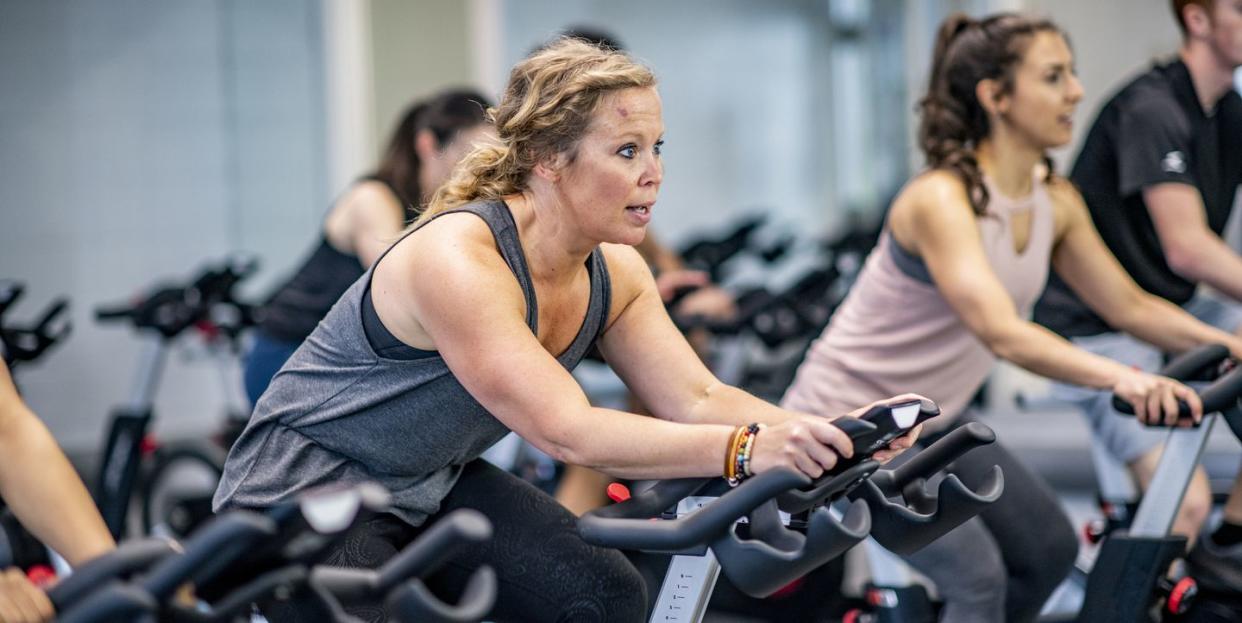How Safe Will Indoor Group Exercise Be This Cold, Flu, and COVID Season?

- Oops!Something went wrong.Please try again later.
A study published in Proceedings of the National Academy of Sciences shows that exercise intensity affects the emission, concentration, and spread of aerosol particles that can lead to illness.
Athletes should take precautions when exercising indoors this cold, flu, and COVID season.
Remember when we used to spend hours in the gym riding an indoor bike, surrounded by others without a care? While we all knew that sneezing and coughing could spread colds and the flu, we didn’t worry as much about the safety of the air around us. This cold/flu/COVID-19 season, maybe we should.
In a study published in Proceedings of the National Academy of Sciences earlier this year, scientists in Munich, Germany demonstrated that “aerosol emissions increase exponentially with intense physical exertion” and “that indoor sporting activities result in a higher risk of infectious diseases, such as COVID.”
To learn more about the indoor spread of viruses, scientists measured the aerosol emissions of eight women and eight men exercising at various intensities. Christian Kähler, Ph.D., professor of fluid dynamics and director of the Institute of Fluid Mechanics and Aerodynamics at the University of the Federal Armed Forces in Munich, and one of the study authors, explains that they found the aerosol particle concentration in expired air increased significantly from rest to maximal intensity.
Also, subjects who were highly trained emitted more aerosol particles than untrained subjects. And while aerosol particle emission increased only moderately with moderate exercise, it increased exponentially with more intense exercise.
“We first measured the number of aerosol particles that [participants] ‘blew out’ per minute at rest,” Henning Wackerhage, Ph.D., molecular exercise physiologist and professor at the Technical University of Munich tells Bicycling. “[Participants] then had to cycle harder and harder until the end of the test.” At rest, participants were breathing about 10 liters per minute of aerosol particles, compared to during maximal exercise, when they were breathing out an average of more than 100 liters per minute.
This is important because aerosol refers to particles that float in the air and can accumulate in a room, almost like water droplets on a foggy day or the scent that you smell when someone sprays perfume. “Aerosol can contain viruses such as the COVID-19 or the flu-causing influenza virus,” explains Wackerhage. Then, they can be inhaled deep into the lungs and cause infections.
Even though the exercisers weren’t breathing directly on one another, the fact that aerosol particles float in the air means it’s important to measure “how many aerosol particles are produced or emitted by a person per minute,” Wackerhage says. “They are not like a tennis ball that lands after 50 meters.” They can travel a large distance and hang around in the air. Plus, we generate even heavier particles when we talk, sneeze, or cough.
“The six-feet rule works well to protect you from the larger droplets, but not from the aerosol that builds up in a small, poorly-ventilated room,” he continues.
Furthermore, other viruses, such as influenza, can also be transmitted via aerosols, but the coronavirus that causes COVID-19 is special because people start to produce coronavirus particles one to two days before they develop symptoms. Therefore, people who don’t realize they are infected will go to the gym, while those with a cold or flu often stay home, he believes.
Because of these findings, Wackerhage suggests taking precaution when it comes to planning indoor workouts this season. “Avoid heavy exercise classes in poorly ventilated venues at times when infection numbers are high. The longer you do this type of exercise, the higher the chance that you will become infected if there is an infected exerciser in the room,” he says.
To keep fit during colder months without increasing your risk of illness, Wackherhage and his research team have several tips:
Go outside to workout whenever you can. Outside is safe as aerosol is quickly diluted.
Avoid high-intensity exercise classes in poorly-ventilated venues, especially if infection rates are high in your area. Remember that someone who doesn’t yet know they are sick may be in the gym.
Do moderate exercise or weight lifting during non-peak hours and ensure that there is enough ventilation either via a building air exchange system or via frequent window opening.
Keep your distance from others.
Wear a mask when things get crowded.
Consider working out at home, if possible.
You Might Also Like

